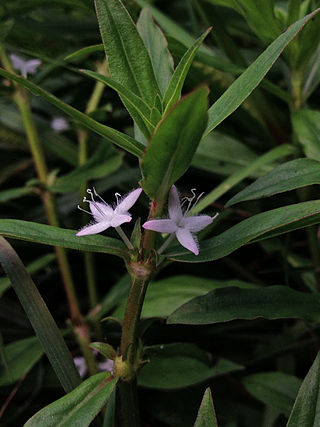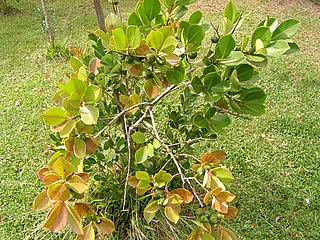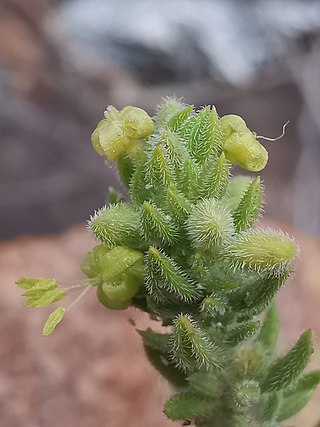
Galium is a large genus of annual and perennial herbaceous plants in the family Rubiaceae, occurring in the temperate zones of both the Northern and Southern Hemispheres. Some species are informally known as bedstraw.

Diodia is a genus of flowering plants in the family Rubiaceae. It was described by Carl Linnaeus in 1753. The genus is found from southern and eastern United States, South America, Central America, Mexico, the West Indies and tropical Africa.

Houstonia (bluet) is a genus of plants in the family Rubiaceae. Many species were formerly classified, along with other genera since segregated elsewhere, in a more inclusive genus Hedyotis.

Casasia is a genus of flowering plants in the family Rubiaceae. These shrubs or small trees occur on the Caribbean islands and in one case in Florida. Some of the ten accepted species were formerly placed elsewhere, e.g. in the related genip-tree genus (Genipa), in Gardenia or in Randia.

Exostema is a genus of flowering plants in the family Rubiaceae. It consists of trees and shrubs, endemic to the neotropics, with most of the species occurring in the West Indies.

Spermacoce or false buttonweed is a genus of flowering plants in the family Rubiaceae. It comprises about 275 species found throughout the tropics and subtropics. Its highest diversity is found in the Americas, followed by Africa, Australia and Asia.
Cephalanthus salicifolius is a species of flowering plant in the family Rubiaceae. Common names include Mexican buttonbush, mimbre, botoncillo, and Jazmin blanco. Its native range extends from the banks of the southernmost stretch of the Rio Grande in Cameron and Hidalgo Counties of Texas through much of Mexico from Coahuila to Oaxaca; a disjunct population exists in Honduras.

Chiococca is a genus of flowering plants in the family Rubiaceae. It currently holds 23 species that are native to Florida, Texas, Mexico, Central America, much of South America, the West Indies, and the islands of Galápagos and Fernando de Noronha.

Catesbaea is a genus of flowering plants in the family Rubiaceae. It occurs in the West Indies, The Bahamas, and the Florida Keys. The genus is named in honour of English naturalist Mark Catesby.
Acrosynanthus is a genus of flowering plants in the family Rubiaceae. It is found in Cuba and Jamaica in the Caribbean.

Chiococceae is a tribe of flowering plants in the family Rubiaceae and contains about 233 species in 27 genera. Most representatives occur from southern Florida to tropical and subtropical America, except for the genera Badusa and Bikkia, which are found from the Philippines to the West Pacific, and Morierina and Thiollierea, which are native to New Caledonia.

Rondeletieae is a tribe of flowering plants in the family Rubiaceae and contains about 178 species in 8 genera. Its representatives are found from southern Mexico to northern South America and in the Caribbean.
Mazaea is a genus of flowering plants in the family Rubiaceae. It is endemic to Cuba.

Margaritopsis is a genus of flowering plants in the coffee family. The genus is found from Mexico to tropical America.
Nernstia is a monotypic genus of flowering plants in the family Rubiaceae. It was described by Ignatz Urban in 1923.

Chimarrhis is a genus of flowering plants in the family Rubiaceae. It has 15 recognized species, native to Central America, South America and the West Indies.
Coutaportla is a genus of flowering plants in the family Rubiaceae. It is found in Mexico and Guatemala.
Colleteria is a genus of flowering plants in the family Rubiaceae. The genus is found in the Caribbean.

Mosiera is a genus of shrubs and small trees in the family Myrtaceae, first described as a genus in 1933. It is native to Mexico, Guatemala, the West Indies, Brazil, and Florida.

Anthospermeae is a tribe of flowering plants in the family Rubiaceae and contains 208 species in 12 genera. Its representatives are found in the Southern Hemisphere, with the exception of the two species of the genus Phyllis. At least two genera, namely Coprosma and Galopina are anemophilous.













